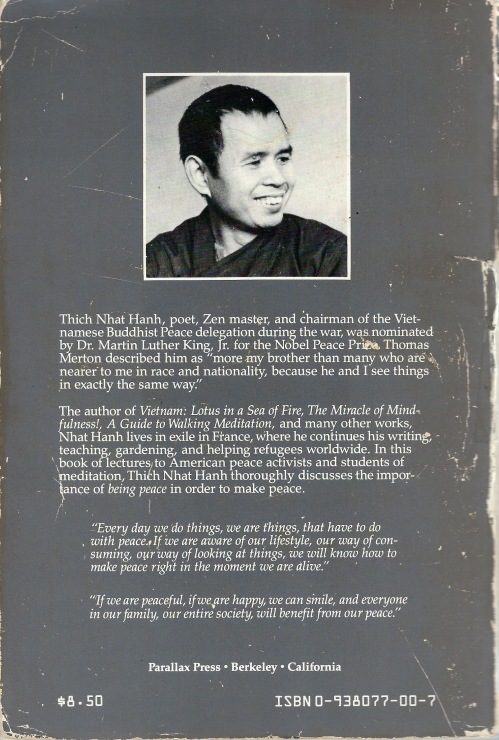Thich Nhat Hanh’s Being Peace was published 31 years years ago, and it remains fresh, challenging, and practical. While there are thousands of books on Buddhism, this short text of 115 pages, graced with the illustrations by Mayumi Oda, can be a sage guide for personal and social transformation.
Being Peace long predates Thich Nhat Hanh becoming an American, even global, spiritual phenomenon. The seven chapters are based on talks he gave in 1985 to U.S. to peace activists and meditation practitioners, not exactly mainstream America. The chapter “Interbeing” gives an inspiring introduction to his community that seeks to practice mindful social action through 14 exacting precepts. Another chapter gives an illuminating, contemporary take on the three traditional refuges in the Buddha, Dharma, and Sangha. There is much here to orient a new student and remind an experienced one of the essentials.
May the following short excerpts prompt you to go to your library and check out this book from a man Daniel Berrigan once described as “foam-rubber dynamite.”
_________________
“In Vietnam, there are many people, called boat people, who leave the country in small boats. Often the boats are caught in rough seas or storms, the people may panic, and boats can sink. But if even one person aboard can remain calm, lucid, knowing what to do and what not to do, hr or she can help the beat survive. His or her expression—face, voice—communicates clarity and calmness, and people have trust in that person. They will lsiten to what he or she says. One suc person can save the lives of many.” 11-12
“On the wooden board outside of the meditation hall in Zen monasteries, there is a four-line inscription. The last line is, ‘Don’t waste your life.’ Our lives are made of days and hours, and each hour is precious. Have we wasted our hours and days?” 33
“The Avatamsaka Sutra tells us that you cannot point to one thing that does not have a relationship with this sheet of paper. So we say, ‘A sheet of paper is made of non-paper elements.’ A cloud is a non-paper element. The forest is a non-paper element. Sunshine is a non-paper element.” 46
“Do you practice breathing between phone calls? Do you practice smiling while cutting carrots? Do you practice relaxation after hours of hard work?” 54
You may not be aware that your country has been manufacturing a lot of conventional weapons to sell to third world countries for their people to kill each other. You know very well that children and adults in these countries need food more than these deadly weapons. Yet no one has time to organize a national debate to look at the problem of manufacturing and selling these deadly things. Everyone is too busy.” 72
“The peace movement can write very good protest letters, but they are not yet able to write a love letter. ” 79
“The first time I visited Buddhist communities in this country I asked a friend, ‘Please show me your Buddha, your American Buddha.’ The question surprised my friend, because he thought that the Buddha is universal. In fact, the Chinese have a Chinese Buddha, Tibetans have a Tibetan Buddha, and also the teaching is different. The teaching of Buddhism in this country is different form other countries. Buddhism, in order to be Buddhism, must be suitable, appropriate to the psychology and the culture of the society it serves.” 84
“In Buddhism is it said that there are 84,000 Dharma doors for you to enter reality. Dharma doors are means of practice, ways of practice. When we ride on a horse that is out of control, I think our deepest wish is to stop. How can we stop? We have to resist the speed, the losing of ourselves, and therefore we must organize a resistance. Spending two hours on one cup of tea during a tea meditation is an act of resistance, nonviolent resistance.” 110
